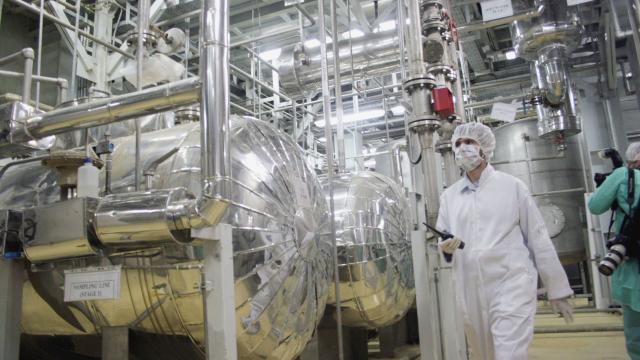Diplomats who have closely observed the International Atomic Energy Agency’s (IAEA) work in Iran said that investigators discovered traces of uranium at a Tehran-based storage facility, Reuters reported on Monday, and that Iran has yet to issue any explanation why.
According to Reuters, vague reports that radioactive material had been detected at the site have been known for some time, but now two diplomats tasked with assisting international oversight of Iran’s nuclear programs have confirmed that it was uranium.
While uranium is one of only two materials that can be used to manufacture a nuclear warhead, one of the diplomats said that the IAEA had determined whatever material was stored there was not highly enriched, “meaning it was not purified to a level anywhere close to that needed for weapons,” Reuters wrote. There are also numerous explanations for the presence of the material, including that it predates the 2015 nuclear deal
The find comes at a time when tensions in the region have grown following the Trump administration’s decision to walk away from the nuclear deal and apply a policy of maximum pressure against Iran and increased sanctions on its economy, which Iran has met with a series of provocations in turn.
Behrouz Kamalvandi of the Atomic Energy Organisation of Iran recently stated that Iran was activating advanced uranium enrichment centrifuges prohibited by the deal, and the country has also began enriching uranium above the terms of the agreement, according to the Associated Press.
Per Reuters, while inspectors have waited months for an explanation regarding the trace amounts of uranium, this delay is not unusual:
In a speech a year ago Israeli Prime Minister Benjamin Netanyahu, who vehemently opposed the deal, called on the IAEA to visit the site immediately, saying it had housed 15 kg of unspecified radioactive material that had since been removed.
Reuters first reported in April that the IAEA, which is policing the nuclear deal, had inspected the site – a step it had said it takes “only when necessary” – and environmental samples taken there were sent off for analysis… The process of seeking an explanation from Iran has lasted two months, the IAEA’s safeguards division chief told member states in a briefing on Thursday, diplomats present said. But he described what it was seeking an answer to far more generally as questions about Iran’s declaration of nuclear material and activities, since the details are confidential.
“It is not something that is so unique to Iran,” a senior diplomat told Reuters. “The agency has these cases in many other situations. Depending on the engagement it can take two months, six months.”
IAEA Acting Director General going to Iran just as IAEA informs its Board that #Iran may be concealing nuclear material and/or activities. We join with other @iaeaorg Board member states eager to get a full report as soon as possible.
— John Bolton (@AmbJohnBolton) September 7, 2019
We are confident that the UK, France, and Germany – indeed, all civilized nations – will take decisive actions to stop Iran’s nuclear extortion.
— Secretary Pompeo (@SecPompeo) September 6, 2019
According to a recent report in the New York Times, many outside observers believe Iran’s breach of certain terms of the deal is designed to compel European nations that were signatories to the 2015 agreement to find ways to relax pressure on its economy rather than restore its prior nuclear capabilities.
The French government had presented Iran with the possibility of gaining access to a $22 billion line of credit to blunt the impact of U.S. sanctions, but the Times wrote that was apparently “contingent on an agreement with the United States not to penalise countries or companies involved in the extension of what amounts to a loan to Iran.” The U.S. State Department has indicated that they see no possibility of such an arrangement coming to fruition.
The Times wrote that Iran has so far only enriched uranium to 4.5 per cent purity, “modestly” above limits set in the deal, but that in statements this weekend, did not indicate whether they would enriching to higher levels such as 20 per cent purity.
“We have started lifting limitations on our research and development imposed by the deal,” Kamalvandi said on Saturday, per the Times. “It will include development of more rapid and advanced centrifuges.”
As for going beyond 20 per cent, the Times wrote, Kamalvandi told Iranian media that “Right now there is no need for that,” but left open the possibility for the future.
[Reuters]
